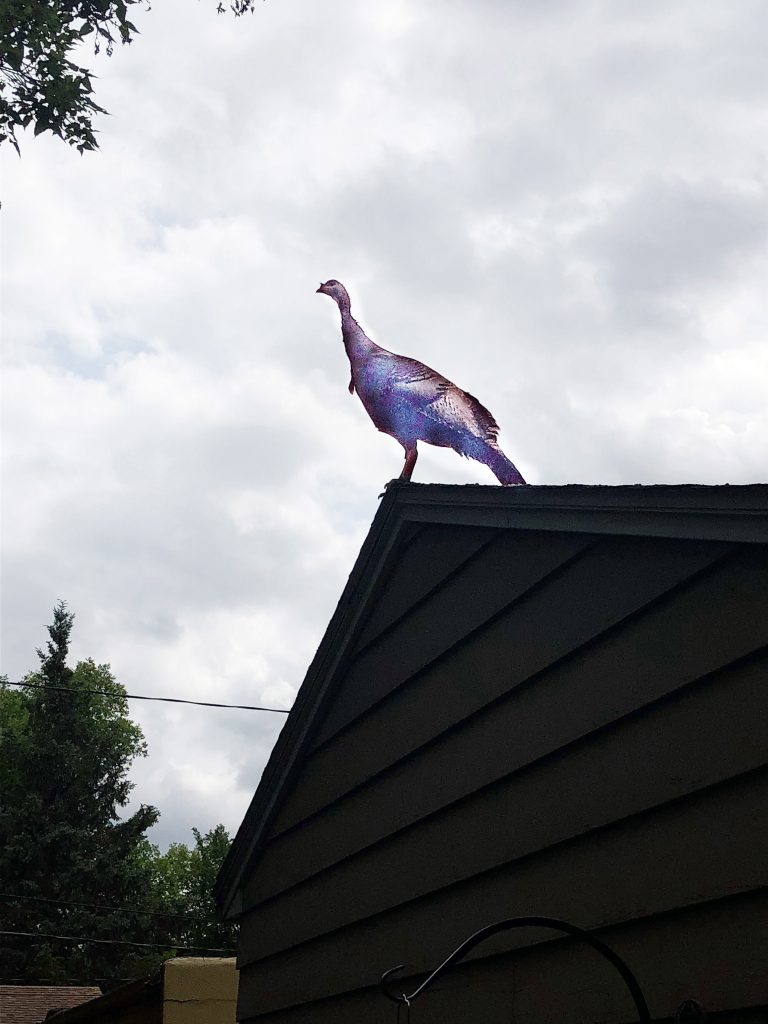
Nancy Edmonds Hanson
hansonnanc@gmail.com
There wasn’t a wild turkey to be found in all of Minnesota just 50 years ago. Then wildlife managers stepped in to bring back the big birds, once native, that had been hunted to near extinction. The result? The most successful wildlife reintroduction in the history of the Department of Natural Resources … and a population boom that some Moorheaders consider a growing nuisance.
Citizens will get together with the Moorhead Police Department, city leaders and the DNR on Wednesday, Jan. 8, to discuss what should – or should not – be done about the flocks within the city limits. The meeting begins at 7 p.m. in the City Council chambers.
Opinions run high in the city, where many have become fond of the sedate, comical caravans of birds strutting across streets and lawns. Other residents are less sanguine. As in many other Minnesota cities, including several twin Cities suburbs, the birds have immigrated along the rivers into urban locales. As their numbers have grown from an occasional novelty to full-fledged families of rapidly growing fledglings, they have become a daily sight – not only along streets and in yards close to the river, but as far east as the Minnesota State University campus.
A dozen turkeys have hung out around the Hjemkomst Center, Crystal Sugar and even the Center Mall in recent years. “They do stop traffic,” says Holly Heitkamp, the director who manages the Hjemkomst and other city parks. “They’ve been known to peck at the tires of buses bringing schoolkids here, and sometimes you see them bobbing their heads outside as they see their reflection in the meeting room windows.
“Generally they’re not a problem, though,” she continues. “Our real problem is residents of the apartments next door who feed them.”
John Rowell, a retired mail carrier who says he spotted his pair along his South River Road route back in 1997, observes they have spread out from neighborhoods along the Red. “Now, near Lamb Park, practically a mile from the river, it’s not uncommon to see a dozen or more out for a stroll. Motorists slow down and stop to avoid hitting them.
“Sometimes people feel inconvenienced by their presence, but as far as I know, there has never been a credible report of a turkey injuring anyone.” Nevertheless, some postal employees in areas where birds have become more dominant are said to carry ice scrapers in case they might need to show more aggressive males who’s boss.
According to the Minnesota Department of Natural Resources website, today’s turkey population descended from a successful release of turkeys that occurred between 1971 and 1973, when 29 adult wild turkeys were trapped in Missouri and transplanted to Houston County in extreme southeastern Minnesota. Since this modest beginning almost 50 years ago, the state’s population has grown from essentially zerocto more than 70,000. It’s a remarkable success story from the biologists’ point of view. The big game birds – males can reach four feet long, weigh up to 24 pounds and have wingspans of up to six feet – are exciting to hunt.
They’re smart, too … bright enough to follow the rivers into protected urban areas like Moorhead, where the eating is easy.
Eleven months ago, the DNR announced an agreement with South Dakota Game, Fish and Parks to trap and transport 75 of the local birds to repopulate the species in eastern South Dakota. That collaboration broke down a week later. South Dakota officials canceled the deal, they said. “It appears they decided that ours are city turkeys, and they want wild birds,” city manager Chris Volkers reported.
The DNR concedes that “as both the human and turkey populations expand in Minnesota, it is only natural to expect that increasing interactions will occur, some of them negative. Some wild turkeys that reside in urban areas have become acclimated to humans, which can create problems.” It offers several tips for avoiding problems: Don’t feed the turkeys, and keep the area beneath bird feeders clean.
The wildlife experts emphasize how important it is to not allow turkeys to become comfortable in the presence of humans. “Don’t let turkeys intimidate you. Chase them away from your residence. Don’t hesitate to scare or threaten a bold, aggressive turkey with loud noises, swatting with a broom or water sprayed from a hose. A dog on a leash is also an effective deterrent.”
What homeowners cannot do, Moorhead police advise, is hunt the birds – or any wildlife – with any weapon. Hunting of all kinds, including shooting a firearm, is forbidden within the city limits, with the exception of certain designated areas in Oakport that were agreed upon when the development was annexed in 2015.
Finally, the DNR urges homeowners intent on controlling turkeys in their neighborhood to educate their neighbors. “Your efforts will be futile if neighbors are providing food for turkeys or neglecting to act boldly towards the birds. It requires the efforts of the entire neighborhood to help keep wild turkeys wild.”


